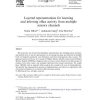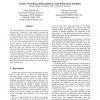55 search results - page 3 / 11 » Temporal Centering |
ICC
2008
IEEE
14 years 3 months ago
2008
IEEE
—This paper addresses the joint estimator and power optimization problem for a sensor network whose mission is to estimate an unknown parameter. We assume a two-hop network where...
SPIN
2001
Springer
14 years 1 months ago
2001
Springer
ions Using SPIN . . . . . . . . . . . . . . . . . . . . . . . . . . . . . . . . . . . . . . . . . . . 16 Marsha Chechik, Benet Devereux, Arie Gurfinkel (University of Toronto) Imp...
SIGSOFT
2007
ACM
14 years 9 months ago
2007
ACM
Model checking techniques have traditionally dealt with temporal logic languages and automata interpreted over -words, i.e., infinite in the future but finite in the past. However...
CVIU
2004
13 years 8 months ago
2004
We present the use of layered probabilistic representations for modeling human activities, and describe how we use the representation to do sensing, learning, and inference at mul...
FGR
2000
IEEE
14 years 1 months ago
2000
IEEE
This paper proposes a state based approach to gesture learning and recognition. Using spatial clustering and temporal alignment, each gesture is defined to be an ordered sequence ...


